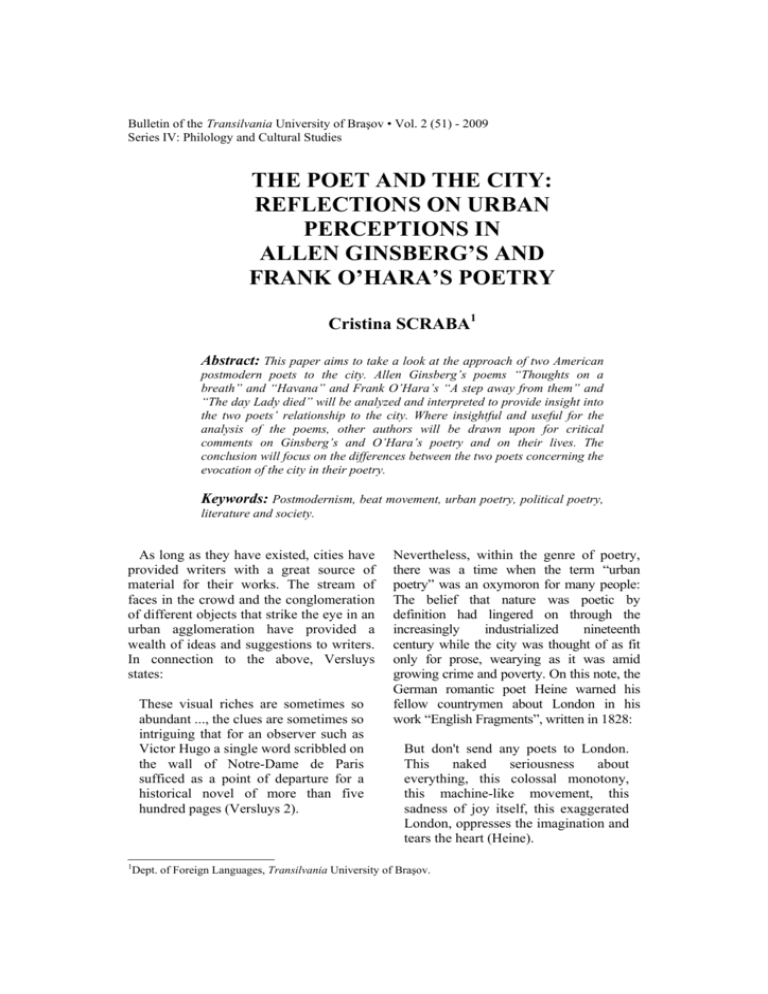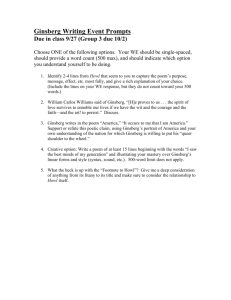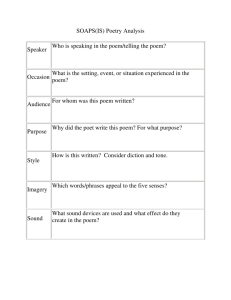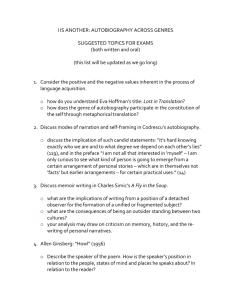THE POET AND THE CITY: REFLECTIONS ON URBAN
advertisement

Bulletin of the Transilvania University of Braşov • Vol. 2 (51) - 2009 Series IV: Philology and Cultural Studies THE POET AND THE CITY: REFLECTIONS ON URBAN PERCEPTIONS IN ALLEN GINSBERG’S AND FRANK O’HARA’S POETRY Cristina SCRABA1 Abstract: This paper aims to take a look at the approach of two American postmodern poets to the city. Allen Ginsberg’s poems “Thoughts on a breath” and “Havana” and Frank O’Hara’s “A step away from them” and “The day Lady died” will be analyzed and interpreted to provide insight into the two poets’ relationship to the city. Where insightful and useful for the analysis of the poems, other authors will be drawn upon for critical comments on Ginsberg’s and O’Hara’s poetry and on their lives. The conclusion will focus on the differences between the two poets concerning the evocation of the city in their poetry. Keywords: Postmodernism, beat movement, urban poetry, political poetry, literature and society. As long as they have existed, cities have provided writers with a great source of material for their works. The stream of faces in the crowd and the conglomeration of different objects that strike the eye in an urban agglomeration have provided a wealth of ideas and suggestions to writers. In connection to the above, Versluys states: These visual riches are sometimes so abundant ..., the clues are sometimes so intriguing that for an observer such as Victor Hugo a single word scribbled on the wall of Notre-Dame de Paris sufficed as a point of departure for a historical novel of more than five hundred pages (Versluys 2). 1 Nevertheless, within the genre of poetry, there was a time when the term “urban poetry” was an oxymoron for many people: The belief that nature was poetic by definition had lingered on through the increasingly industrialized nineteenth century while the city was thought of as fit only for prose, wearying as it was amid growing crime and poverty. On this note, the German romantic poet Heine warned his fellow countrymen about London in his work “English Fragments”, written in 1828: But don't send any poets to London. This naked seriousness about everything, this colossal monotony, this machine-like movement, this sadness of joy itself, this exaggerated London, oppresses the imagination and tears the heart (Heine). Dept. of Foreign Languages, Transilvania University of Braşov. 30 Bulletin of the Transilvania University of Braşov • Vol. 2 (51) - 2009 • Series IV According to Simmel, even nowadays man’s alliance with and relationship to the city tends to be a rather uneasy one, since the city compels man to “react with his head instead of his heart” (Simmel 48): The impressions the city leaves on one’s mind are tumultuous and violent and unfortunately, the greater the share of the shock factor in particular impressions, the more constantly consciousness has to be alert as a screen against stimuli; the more efficiently it does so, the less do these impressions enter experience (Erfahrung), tending to remain in the sphere of a certain hour in one’s life (Erlebnis) (Benjamin 159). Thus, city experiences tend to remain registered just as simple occurrences, in what Freud called consciousness, instead of passing to the core of the human personality, to the seat of the imagination, to what Freud called the unconscious (Benjamin 159). Therefore, the city does not seem to be the ground on which poetry would grow properly. Versluys offers the solution to this obvious dilemma when he claims that in order to approach and succeed in the field of urban poetry “chaos has to be transformed into harmony ..., dead stones have to be infused with life, and more important, the poet has to give a face to the faceless” (Versluys 3). Objects and incidents to which the average city dweller reacts with cold intellectualism need to be approached with emotional warmth. Only if relating the deepest layer of his personality to what is generally considered depersonalized, mechanized and alienated will a poet succeed in the field of urban poetry (Versluys 3). This paper aims to take a look at the approach of two American postmodern poets to the city. Allen Ginsberg’s poems “Thoughts on a breath” and “Havana” and Frank O’Hara’s “A step away from them” and “The day Lady died” will be analyzed and interpreted to provide insight into the two poets’ relationship to the city. Where insightful and useful for the analysis of the poems, other authors will be drawn upon for critical comments on Ginsberg’s and O’Hara’s poetry and on their lives. The conclusion will focus on the differences between the two poets concerning the evocation of the city in their poetry. 2. Allen Ginsberg and the City Allen Ginsberg’s (1926-1997) numerous travels and his nomadic existence marked his lifestyle and his poetry. He made various trips and also spent some time outside the United States. His trips took him to Cuba and Mexico once, where he spent half year. He also spent one and a half year in Europe mainly living in Paris, had been in South America for six months and more than a year in India. In America he mainly divided his time between New York and San Francisco, with innumerable stops in between (Burns 236). In “Thoughts on a breath”, the speaker is in the middle of the city, watching the cars, the trees and the buildings around him (Ginsberg 24). The speaker senses that he completes a “cycle” by sitting just as he sat in the same place “four years ago”. “To sit” refers to the practice of meditation which begins with correct gesture during sesshin, i.e. a period of intensive meditation in a Zen monastery (Aitken). He ponders: “What’ve I learned since I sat here four years ago?” and “what was it I began my meditation on?” Proceeding, he enumerates the things he had been thinking about all these years, as announced by the title, “on a breath”: Police state, Students, Poetry open tongue, Anger and fear of Cops, oil Cops, Rockefeller Cops CIA Cops FBI Cops Goon Squads of Dope Scraba, C.: The Poet and the City: Reflections on Urban Perceptions in … He continues to enumerate more things which bother him: the “Cops” who “busted Stony Burns and sent him to/ Jail 10 years and a day/ for less than a joint of Grass”, as well as the passivity of people who do not protest against all these wrongs, of which they do not seem to be aware. He grumbles at the people because they are not able to see how we “work with our hands/ like niggers growing Crops in the field/ & plough and harvest our corny/ fate.” He deplores them because they are not able to see that by continuing to behave as though things were normal, they support the perverted purposes of the politicians (“Oh intellect of body back & Cock whose red neck/ supports the S &M freaks of Government/ police & Fascist Monopolies”). On an ironical note he addresses Whitman and other spiritual teachers of his who did not do much to stop this negative evolution although they had realized a long time before that America would evolve in this direction (“Oh Walt Whitman salutations” – “Homage/ to the Gurus, Guru om! Thanks to the teachers/ who taught us to breathe,/ to watch our minds revolve in emptiness, to follow the rise & fall of thoughts”). The poem ends on a passionate, idealistic tone with a promise: The speaker vows “to liberate all” the people from their (unperceived) slavery. As to the references to the city in “Thoughts on a breath”, the poem provides a rich description of the city as a setting: The speaker visually sketches the setting by describing what he sees around him: Cars slide minute down asphalt lanes in front of Dallas Hilton Inn Trees brown bare in December’s smog-mist roll up to the city’s squared towers beneath electric 31 wire grids trestled toward country water tanks ... Majestic in a skirt of human fog, building blocks rise at the sky edge, Branches and house roofs march to horizon By mentioning the cars on a freeway, the rolling of the motors, the speaker also provides auditory elements, a noise typical of the city: ear roar oil exhaust, snuffle and bone growl motors rolling North Central freeway. Up to this point, the evoked city images and noises are neutrally or positively connoted: The cars the speaker watches “slide … down asphalt lanes”, the buildings which “rise at the sky edge” are “majestic”. From now on the evoked city images are negatively connoted: The “Energy playing over Concrete energy/ hymning itself in emptiness” suggests something positive which ends as something negative: Energy is pictured as wasted energy. Besides this negative suggestion about civilization which wastes itself, Ginsberg provides other images of the city which are negatively connoted, as exemplified by the following stanza: Massive metal bars about monster machines eat us, Controlled by army, Cops, the Secret Police, our own thoughts! Punishment! Punish me! Punish me! we scream in our hearts A tool which helps to analyze this stanza is provided by Frye’s description of “demonic imagery” which he discusses in his Anatomy of Criticism: 32 Bulletin of the Transilvania University of Braşov • Vol. 2 (51) - 2009 • Series IV Cities of destruction and dreadful night belong here ... Images of perverted work belong here too: engines of torture, weapons of war, armor, and images of a dead mechanism which, because it does not humanize nature, is unnatural as well as inhuman. ... We have the prison or dungeon, the sealed furnace of heat without light, like the City of Dis in Dante. Here too are the sinister counterparts of geometrical images: the sinister spiral ..., and the sinister circle, the wheel of fate or fortune. ... Corresponding to the apocalyptic way or straight road, ... we have in this world the labyrinth or maze, the image of lost direction, often with a monster at its heart like the Minotaur (Frye 150). It is quite evident that one could apply Frye’s catalogue not simply to passages from “Thoughts on a breath”, but to the whole range of, as Burns phrases it, “Molochism” in Ginsberg’s work. Burns claims: In ‘Howl’… this imagery is everywhere, precisely in Frye’s sense: there is the prison, the geometrical images, the maze of negro streets opening the poem, the monster Moloch at the heart of the labyrinth, and in a further concentration of metaphor, the maze has become the winding entrails inside the sinister monster himself (Burns 384). Schorer claims that by evoking such a demonic imagery, Ginsberg creates “a nightmare world in which people representing ‘the best minds of [Ginsberg’s] generation’ [, his fellow poets and artists,] are wandering like damned souls in hell” (Ferlinghetti 151). And because the main geography evoked in ‘Howl’ represents New York, this nightmare world is suggested to be the city itself. As to the passage from “Thoughts on a breath” quoted above, one cannot deny that these lines suggest an image of hell. The chosen vocabulary supports this demonic imagery: The “monster machines” which are “controlled by the army” “eat us”. And as suggested by Ginsberg through the whole poem, we who support by our actions the “S & M freaks of Government” are the victims who “scream”: “Punish me!” The image of a hell where people are eaten by monsters is well evoked. Admittedly, it is a paradoxical hell with victims who choose to remain victims by allowing themselves to be punished, but it still represents hell. Once again associating the portrayed image of New York in “Howl” and Schorer’s idea of damnation to the image of the city portrayed in “Thoughts on a breath”, one can say that the chosen demonic imagery in “Thoughts on a breath” fulfills its task by successfully conveying the poem’s symbolic meaning: It is a “howl”, a protest against everything in our alienated civilization which kills the spirit. Nonetheless, however dark the pictured world seems, the poem does not end in hopelessness and despair: Masterfully exploiting his technique, Ginsberg manages to create a poem which gathers its positive force and energy from its speaker who is driven by redemptive love for his fellow humans and who assumes that the louder he shouts the more likely he is to be heard. Ginsberg’s poem “Havana” evokes the city by describing a bar in Cuba’s capital as being part of the city life (Ginsberg 38). The speaker is drunk and he is simply sitting and recording his impressions and the atmosphere of a scene which is not at all unusual. After carefully setting the scene (“by Aedama Palace/ on Gomez corner”), Ginsberg conveys the reader a Scraba, C.: The Poet and the City: Reflections on Urban Perceptions in … certain feeling of milieu: His speaker provides details by displaying visual and acoustic elements of the interior and the exterior of the bar: white men and women with standing drums, mariachis, voices, guitars — drumming on tables, knives on bottles, banging on the floor and on each other, with wooden clacks, whistling, howling, fat women in strapless silk. One can also enjoy a tight catalogue of sounds with some playfully added stage directions for a (Cuban) dog in the middle: voices across the street, baby wail, girl’s squeak, ... grumble and cackle of young boy’s laughter in a streetcorner waits, perro barking off-stage, baby strangling again, banjo and harmonica, auto rattle The speaker tips the mariachi players 25 cents to play “Jalisco” and at the end of the song oxcart rolls by obtruding its wheels O’er the music o’ the night. The poem ends as if the theater curtain has fallen at the end of an act. It ends rather unspectacularly, except for the linguistically playful note, due to the alliterations and the traces of old poetic diction in the last line, “o’er and o”. One could say that before one’s eyes a new reality has been created. 33 3. Frank O’Hara and the City After attending Harvard, Frank O’Hara (1926–1966) moved back home to Michigan for a short period. In 1951 he went to New York where he lived until his death (Gooch 5). O’Hara wrote “A step away from them”, using a pedestrian’s voice (O’Hara 12): “It’s my lunch hour, so I go for a walk among the hum-colored/ cabs”. His speaker goes West and then downtown, goes past some construction sites on Sixth Avenue, through Times Square where he stops for a cheeseburger and a glass of papaya juice beneath the Chesterfield billboard with blowing smoke, and then goes back uptown to work. As Allen Ginsberg told an interviewer, “He [O’Hara] taught me to really see New York for the first time, by making of the giant style of Midtown his intimate cocktail environment” (Gooch 288). Gooch sustains Ginsberg’s statement concerning O’Hara’s intimate relationship to the city by claiming: O’Hara was fired by the challenge of finding the good in the bad, the poetic in the mundane, the ancient and divine in modern New York. ... His tendency, like Whitman’s, was to mythologize his daily life (Gooch 288). In line with this affirmation, in “A step away from them”, even construction workers seem mysterious and glamorous and exotically sensual: First, down the sidewalk where laborers feed their dirty glistening torsos sandwiches and coca-cola, with yellow helmets on. They protect them from falling bricks, I guess. 34 Bulletin of the Transilvania University of Braşov • Vol. 2 (51) - 2009 • Series IV Likewise, the growing Puerto Rican population of the city is positively mentioned in the poem: “There are several Puerto/ Ricans on the avenue today, which/ makes it beautiful and warm”. O’Hara evokes the city by portraying an everyday walk as part of his life. The poem sounds as if it was an assembly of enticing, vividly described sounds and sights of the city: cabs hum, laborers are eating sandwiches and drinking Coca-Cola, the skirts of girls in high heels “flip” and “blow up over/ grates”, the cut-rate jewelry shops on 6th Avenue try to outdo each other with “bargains in wristwatches”, “the huge Chesterfield ad above Times Square blows smoke at the cigarette-friendly pedestrian, a black man in a doorway makes eyes at a blonde chorus girl walking by”. Intriguing, too, are in this context the absurd contradictions typical of New York life: The “neon in daylight”, the “lightbulbs in daylight” and “the ladies with poodles who wear fox furs even on the hottest summer day”. But the true subject of the poem is revealed in its title: In “A step away from them” O’Hara ponders on the death of his friends: First, Bunny died, then John Latouche, then Jackson Pollock. But is the earth as full as life uses full, of them? The closeness of death, the awareness of decay and change, of “the Manhattan Storage Warehouse/ which they’ll soon tear down”, make him pay more attention to his surroundings: He begins to watch tiny objects, such as wristwatches, and the people around him more carefully, in this way celebrating the poetry of everyday life. The poem ends with the speaker returning to work with a book of Reverdy’s poems in his pocket, his walk having led neither to sadness nor happiness but to an affirmation of his place in his (city) world. “The day Lady died” is a poem very much similar to “A step away from them” (O’Hara 18). The poem begins with O’Hara mentioning the date and the setting of the poem: “It is 12:20 in New York a Friday”. He then proceeds nonchalantly commenting on his evening schedule: I will get off the 4:19 in Easthampton at 7:15 and then go straight to dinner and I don’t know the people who will feed me. On his walk, the speaker goes to the bank and to a liquor store and after asking the “tobacconist in the Ziegfield Theatre” for a “carton of Gauloises and a carton/ of Picayunes, and a New York Post”, he sees “her face on it”. There is no name mentioned but the last stanza reveals the identity of the person he reads about in the newspaper: And I am sweating a lot by now and thinking of leaning on the john door in the 5 SPOT while she whispered a song along the keyboard to Mal Waldron and everyone and I stopped breathing. Because of the mention of Mal Waldron’s name, the reader learns that the person the speaker is talking about is Billie Holiday: Mal Waldron was a pianist; he was Billie Holiday’s accompanist the two years before she died (Walker). Just as in “A step away from them”, the poem is conceived as a banal approach to an earnest genre: The elegy only reveals itself as an elegy at the end of the poem, with the last stanza. The poem could easily have the whole world mourn Billie Holiday’s loss; instead, it is conceived as a day in the life of the speaker and his city, Scraba, C.: The Poet and the City: Reflections on Urban Perceptions in … with the speaker noticing visual and acoustic elements of the city setting (“Miss Stillwagon, the Park, Lane Liquor Store, the tobacconist in the Ziegfeld Theatre” and “the whispered song”); the only odd occurrence involves Miss Stillwagon at the bank, who “doesn’t even look up my balance for once in her life”. Apart from that, the city is its normal self, the speaker follows his routine up to the moment of buying “a New York Post with her face on it”. The climax is the discovery of “Lady’s” death and the unforgettable memory of one song that lives on. Death, as can also be seen from “A step away from them”, is here too one of many random things that occur in life, making everything “from a shoeshine to a bottle of Strega purchased in a liquor store gain a new significance” (Elledge 58). 4. Conclusions Allen Ginsberg evokes the city as a place he feels at home in. He visually and acoustically describes both Havana and Dallas. While in “Havana” he prefers to approach the city setting as a tourist or a spectator, in a rather playful manner, not in the mood to interfere, the city images the poet evokes in “Thoughts on a breath” are not only negatively connoted, but in certain passages, there is also evidence of “demonic imagery”, which suggests a sort of nightmare world as the epitome of an alienated civilization associated with the city. O’Hara evokes the city as a familiar place for himself as well. The image of the city he displays is a thoroughly positive one; New York is pictured as a place with a pleasant atmosphere. Although his speaker sometimes reveals absurd contradictions when depicting the city, one is aware that these contradictions are typical of New York life. 35 While Ginsberg is concerned with ideas of perverted politics and drug policy, with the alienation and confusion of urban life, O’Hara concentrates on sensations: Though funny, chatty and moving, as O’Hara’s poems are, they do not offer the reader a slice of the real life of those times: His New York seems to be not only far from Ginsberg’s image of the city but even farther from the very real crime- and drugridden Manhattan of the end of the fifties and the beginning of the sixties. Although one cannot find many similarities in Ginsberg’s and O’Hara’s poetry, either concerning content or technique, the achievement of these poets is great. One may not agree with the way certain aspects have been dealt with, but it is undeniable that the city is brilliantly described by Ginsberg and O’Hara, both visually and acoustically. Both of them succeeded in approaching objects and incidents in the city with great emotional warmth, in their own different personal style, of course. For both of them the city was a place of possibility, an exciting place to be, and their poems have an immediacy that draws its energies from the pace and rhythms of city life. Of even greater importance for literature and for us, their readers, both poets succeeded in providing an extraordinary framework for the discussion of postmodern urban poetry. References 1. 2. 3. Aitken, Robert. Some words about sesshin for newcomers to zen practice. http://www.esolibris.com/articles/med itation/sesshin_newcomers.php, accessed April 1, 2009. Benjamin, Walter. Illuminations. London: Fontana Press, 1992. Burns, Glen. Great poets howl. A study of Allen Ginsberg’s poetry. 1943-1955. Frankfurt am Main: Peter Lang, 198. 36 4. 5. 6. 7. 8. 9. Bulletin of the Transilvania University of Braşov • Vol. 2 (51) - 2009 • Series IV Elledge, Jim. Frank O’Hara: To be true to a city. Ann Arbor, MI: University of Michigan Press, 1990. Ferlinghetti, Lawrence. “Horn on howl”. Evergreen Review vol. 1, 4 (1957): pp. 151-160. Frye, Northrop. Anatomy of criticism: Four essays. New York: Atheneum, 1967. Ginsberg, Allen. Mind breath: Poems 1972-1977. San Francisco, CA: City Lights Books, 1985. Gooch, Brad. City poet: The life and times of Frank O'Hara. New York: Knopf, 1993. Heine, Heinrich. Englische Fragmente. (chap. II: London). URL: http://gutenberg.spiegel.de/?id=5&xid =3894&kapitel=3&cHash=e00483092 2chap002#gb_found, accessed April 1, 2009. 10. O’Hara, Frank. The collected poems of Frank O’Hara. Los Angeles, CA: University of California Press, 1995. 11. Simmel, Georg. “The metropolis and mental life”. Classic essays on the culture of cities. Ed. Sennet, Richard. New York: Appelton-Century-Crofts, 1969. pp. 47-60. 12. Versluys, Kristiaan. The poet and the city. Chapters in the development of urban poetry in Europe and the United States (1800-1930). Tübingen: Günter Narr Verlag, 1987. 13. Walker, Bruce. Mal Waldron Biography. URL: http://www.musicianguide.com/biogra phies/1608003760/Mal-Waldron.html, accessed April 1, 2009








